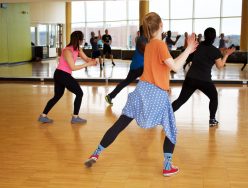As trainers work with children and teens on the autism spectrum, it is very important that they work hand in hand with other caregivers. Many of the effective tools they use can also be employed successfully in the fitness environment.
The tools show what behavior is to be expected in certain situations, visual aids to remind them of acceptable behavior and options shown to independently monitor their own behavior.

One method of improving behavior is a token system, doing at least a few activities that are non-preferred and then getting a break with a preferred activity. A token system shows that after two to five activities, they are given a break. Some children enjoy toys and others find a preferred fitness activity, such as bouncing on a ball as an effective break. Using a timer such as your watch, an inexpensive dollar store or kitchen timer can visually show and remind the participant how long is each individual activity and break.
Visuals for rules are important to implement and review every day. Functioning as a strip of reminders such as what to do when they get upset, the steps in an activity and the order of the schedule are important as the child/teen navigate their way around the gym. Simple rainbow colors or numbers can be implemented for even the nonverbal participant to show how they feel or what they need right now.
Social Stories are simple stories with or without pictures that show what is expected in a certain situation. These stories are read at least once a day to encourage appropriate behavior such as following directions, keeping your hands to yourself, etc.
Option or choice cards give the person the power to do what is expected, even if it is not in the order of the trainer’s preference. Behavior such as getting upset can be cited on choice cards to give alternatives to behavior. Steps for what to do when getting upset are also key ingredients for stopping a non-preferred behavior.
Where to stand and sit can be made easily in a gym with electric tape and rubber dots in a line or feet with names on them placed on the floor. Boundaries can be made with tape and show where the person is to go or stand during an activity. Sometimes, it is also helpful to have signs with pictures of the desired activity as well as numbers placed on the wall to show direction and give independence to the participant once they engage in a specific activity.
Lastly, music that either the participant likes, one that goes along with the activity, or calming music can be effective in the fitness session. Trainers with a projection screen might want to have a calming nature video such as beautiful scenery, animals, or a fishbowl to add to the fitness experience.
Working with participants who have disabilities can be very challenging. However, I have also observed that it is extremely rewarding and necessary in a person’s development. It is our job as trainers to provide the best in fitness to all the participants we have an opportunity to work with. By just getting out of my comfort zone, I have found that my greatest fulfillment as a trainer has been working with this population.
Autism Speaks
https://www.autismspeaks.org/docs/sciencedocs/atn/visual_supports.pdf
Christine Reeves
https://www.teacherspayteachers.com/Browse/Search:christine%20reeves
Autism Speaks
https://www.autismspeaks.org/docs/sciencedocs/atn/visual_supports.pdf
8 Types of Visual Student Schedules
http://theautismhelper.com/10-types-visual-student-schedules/
Using Visual Schedules: A Guide for Parents
https://www.iidc.indiana.edu/pages/using-visual-schedules-a-guide-for-parents
Visual Schedules Series: 7 Reasons to Use Schedules
https://www.autismclassroomresources.com/visual-schedules-series-7-reasons-to/
Visual Supports
http://www.autism.org.uk/visualsupports
Was this Article Helpful?
If this article was helpful to you, please consider linking this article to your own blog or sharing this through the social buttons below. You will also find other great articles at “Special Populations“.
- 9shares
- 8Facebook
- 0Twitter
- 1Pinterest
- 0LinkedIn
Christina Chapan
Latest posts by Christina Chapan
- Body Language for Personal Trainers,Teachers and Group Instructors - January 12, 2020
- Allergies + Exercise: An Overview - January 9, 2020
- The Safety of Running Solo - January 5, 2020


















